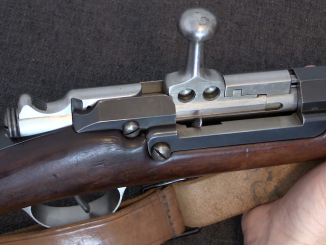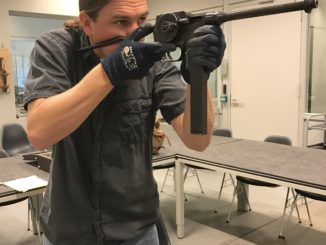The Berthier was adopted in 1890 as a new repeating rifle for the French cavalry, who were at that time still using single shot Gras carbines. The Lebel rifle had been adopted in 1886 for the infantry, but because of its tube magazine it was not conducive to being shortened into carbine form. Andre Berthier devised a way to combine the basic action of the Lebel with the Mannlicher clip system, resulting in a light and handy repeating carbine.
The majority of these carbines were made in 1890 and 1891, and have full length stocks without any provision for bayonets (since the cavalry already had their sabers). A few more were made between 1900 and 1904, and a final order for 40,000 was placed in 1905, but it is unknown if they were actually built. Total production was either 160,000 or 200,000, depending on that last order.
It was not long into World War One when it became clear that cavalry were not suited to trench warfare, and the French cavalry units were repurposed as infantry. As a result, these cavalry carbines were rebuilt in the 1892 infantry pattern when damaged, and after the war all the surviving examples in original configuration were rebuilt as well. This makes them quite rare today in original form.





Alas, the idea of a cavalryman being able to smite a generic enemy with his sword in the age of mechanized warfare only works when his enemies are REALLY STUPID!!
“age of mechanized warfare only works”
In 1890 there were practically no mechanized warfare, also probably almost no-one excepted that there will be “Great War of Trenches”
“only works when his enemies are REALLY STUPID!!”
What if enemy start panic? Notice that cavalry at that time (1890s) was fastest available unit, so can make surprise attack.
Well, the issue of panic is true. The Battle of Danny Boy is a good example where British soldiers decided to use bayonets against the Mahdi army. Said insurgents had been taught that westerners were nothing but spineless cowards, and you can guess what the insurgents did upon seeing the British CHARGE RIGHT INTO THEIR RANKS AND THEN BEGIN STABBING THEIR FRIENDS TO DEATH. They ran for their lives, of course. And must I mention the Charge of the Savoia Cavalleria at Izbushensky?
As noted by Daweo, 1890 is well before the era of mechanized warfare.
France and Britain had extensive colonial empires in Africa, the Middle East, and India. They faced enemy cavalry who by and large had inferior firearms, but had superior numbers, were armed with swords as well as firearms, and were very aggressive. These enemies would as a result try to bring the fighting to close quarters hand to hand combat as quickly as possible as they saw this as the way to even up the odds despite their inferior fireams. If you are fighting hand to hand on horseback and your enemy has a sword and you don’t, you are at a severe disadvantage. You can parry (block the other guy’s sword) and riposte (return the attack) with a sword, you cannot parry with a pistol and trying to use a bayonet from horseback is an exercise in futility. Hence, the need for swords.
By the turn of the century and into WWI, swords used in Europe changed from cut and thrust to ones which were focused on thrusting, such as the 1908 pattern. These should be considered to be more like having a bayonet which can be used held in one hand on horseback. Bayonets were still a valid and important weapon in WWI and beyond.
The first German soldier killed by a British soldier in WWI was killed with a 1908 pattern sword.
“1908 pattern”
In Soviet Union шашка model 1927, see photos here:
http://raritet-salon.ru/shashka-kavaleriyskaya-obr-1927-g-sssr-ref-697-45
was produced until 1946.
–
I’m not sure what is proper English name for шашка, but it should be noted that this is NOT sabre – it differs in balance and lack advance fencing (though, this mean it is easier to learn)
шашка are known in English by the romanization shashka, and are considered a type of sabre- that is, a single-edged backsword for cavalry.
Or used at the right opportunity….It worked with a lance in the Brusilov Offensive…a friend of mine’s great-great uncle who was in the KuK Infantry back in 1916 was killed by a Cossack lance during a retreat. Cavalry is all situational. Bad against Germans on the Western Front, good against the Turk in Jerusalem.
Thanks to these introductions I have growing appreciation of French military rifles. I look at details such as machining finish, colour of metal surfaces (guessing on treatment) and as much as I can, guess on fit of parts. They are definitely well made although with some quirks (such as non-removable bolt).
One thought which occurred to me before is coming back… looking at this 2-piece bolt, it resembles the one from Mosin-Nagant. The difference is that Mosin’s bolt head is loosely connected without screw, which may be reason for its legendary sticking.
The Mosin’s bolt sticking is almost invariably caused by improper/incomplete cosmoline removal in the chamber and bolt components. Once properly cleaned, the bolt works as well as an other military bolt action.
Respectfully, I have to disagree a bit. Sometimes the Mosin-Nagant vintovka’s bolt will seize up during primary extraction. Cocking the bolt first, by pulling back on the cocking knob, sometimes assists in removing the enormous tension on the main spring on the cock-on-opening design. I’ve had frequent stuck cases using crummy 1950s-era lacquered steel case ammunition too. I have had to knock the empty case out of the chamber with a rod much as Ian described in his informative Berthier video.
The “cannon grease” or cosmoline must be removed, the hot dip rebluing remains! The cam surface between the bolt body and the cocking knob screwed to the firing pin can be polished and oiled. At the end of the day, however, one is left with a separate bolt head being torqued to 90 degrees, turning the two locking lugs out of their mortises by a tiny lug–almost a separate bolt handle of sorts–through the bolt body, which is simultaneously drawing back the firing pin and cocking knob, and with additional friction from the non-moving “bolt connector bar” that holds the bolt assembly together and does not rotate, also serving as the bolt stop. I like my 19th century firearms very much, but no way does the Mosin bolt operate “as well as any other military bolt-action.” It is robust. It is generally reliable, simple, and rugged. It may work in extreme cold a bit better due to the tolerances. But it is not like, say, an Arisaka or MAS Mle. 1936 or Lee Enfield or some Mausers…
I am so excited!!! Ian is doing rifles I have in my collection!!! Well, except for the next one, I have not been lucky enough to find a cuirassiers version as of yet. Keep up the good work Ian!!!
Did you measure 3-round burst time?
They couldn’t shorten the Lebel into a satisfactory carbine what with tubular magazine loading on horse-back and so on …Wouldn’t work right with four cartridges in the tube magazine, etc. So they created a 3 round en-bloc magazine because of the shape of the Lebel smokeless powder cartridge! So many “work arounds” while meanwhile the engineers have semi-auto rifles “waiting in the wings…” and there they remained! Sacre bleu!
Hello forgottenweapons.com
Dominate Google Page 1 In Minutes
Newbie Friendly Software: Ranks on Google & YouTube Within 60 Minutes Regardless of Niche – With Just 4 Clicks… Guaranteed
Breakthrough Software Gets You Unlimited FREE TRAFFIC From Google & YouTube… In Minutes
Ranking almost instantly on Google is like finding ‘The Holy Grail when it comes to driving free online traffic.
How much Free Targeted Traffic can you drive in the next few hours?
* Imagine: What you can achieve now you can jump straight to the top of Google…
* Imagine: How much traffic you could drive to your websites, ecom stores, to your offers, or direct to affiliate offers
* Imagine: How much you can make each day when you can Rank on Google in Minutes.
IF YOU’RE INTERESTED, CONTACT ME ==> videosumo@mail.com
Regards, Margie
Australia, VIC, North Wonthaggi, 3995, 72 Mills Street
Excellent blog here! Additionally your web site quite a bit up
fast! What host are you the use of? Can I get
your affiliate hyperlink in your host? I wish my site loaded up as fast as yours lol